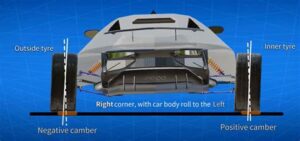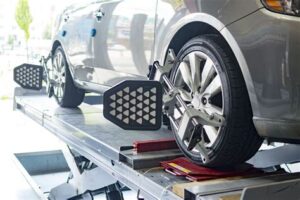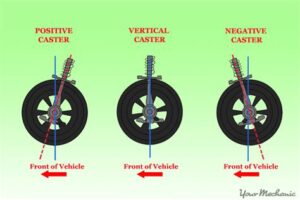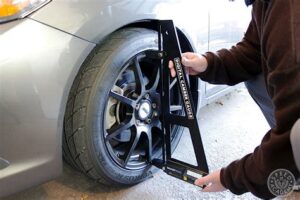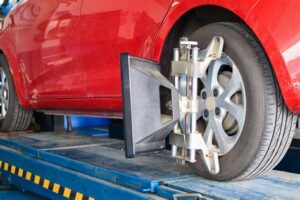Discover the key signs of tire issues, including uneven wear, pulling, vibrations, and noise, to keep your vehicle safe and performance optimal.Is your car handling differently lately? Proper alignment is crucial for your vehicle’s performance, safety, and tire longevity. When wheels are misaligned, they can cause uneven tire wear and impact your driving experience. Signs of alignment issues often manifest in various ways, including your vehicle pulling to one side, an off-center steering wheel, vibrations, or even the unsettling sound of squealing tires. In this blog post, we’ll explore these telltale signs and equip you with the knowledge to identify when your car needs alignment. Understanding these symptoms not only helps you maintain your vehicle’s health but also ensures a smoother, safer ride on the road. Let’s dive into how you can spot alignment problems before they escalate!
Uneven Tire Wear
Uneven tire wear is one of the most common signs that your vehicle may need alignment. When the tires on your car do not wear uniformly, it can lead to reduced traction and handling, compromising your safety on the road.
Several factors can contribute to uneven tire wear, including incorrect tire pressure, misalignment, or worn suspension components. Tires should ideally wear evenly across the tread; however, if you notice that one side of the tire is more worn than the other, it’s important to address the issue promptly.
To check for uneven tire wear, look for differences in tread depth, bald patches, or sidewall damage. Regularly inspecting your tires can help catch these issues early and prolong the life of your tires.
If you identify uneven tire wear, it’s highly recommended to visit a professional mechanic. They will conduct a thorough examination of your vehicle’s alignment, suspension, and tires, ensuring all elements are in top condition.
Vehicle Pulling to One Side
One of the most common signs that your car needs an alignment is if it is pulling to one side while driving. This issue can be both annoying and dangerous, as it may affect your ability to steer your car effectively. If you find yourself constantly adjusting the steering wheel to keep your vehicle straight, it is time to consider an alignment check.
There are several causes for a car to pull to one side, and understanding these can help you address the situation more effectively. Uneven tire wear, alignment issues, or even brake problems can lead to this condition. For instance, if your tires are wearing unevenly, it may indicate that the wheels are not aligned correctly, leading to discrepancies in handling. Always look for signs of irregular wear, such as balding on one side of the tire.
To address this issue, it is recommended to visit a certified mechanic who can perform a complete alignment check. Often, a simple wheel alignment service can resolve the issue of pulling to one side, improving both your driving experience and vehicle safety. Regular maintenance, including checking and balancing your tires, can help prevent these issues from occurring in the first place.
Off-Center Steering Wheel
An off-center steering wheel is a common sign that your car may need an alignment. When your steering wheel is not aligned properly, it can indicate that the wheels of your vehicle are not pointing in the right direction. This misalignment can lead to various driving challenges and safety issues.
Driving with an off-center steering wheel can feel uncomfortable and may distract you from focusing on the road. You may notice that you have to hold the steering wheel at an unusual angle to keep the vehicle moving straight. If you find yourself constantly adjusting the wheel, it’s time to address the issue.
To ensure your safety and the longevity of your car, it’s crucial to get your alignment checked. Ignoring an off-center steering wheel can result in uneven tire wear, increased strain on your vehicle’s suspension, and can potentially lead to more costly repairs in the future. Regular maintenance is key to a smooth and safe driving experience.
Vibration in the Steering Wheel
Experiencing vibration in your steering wheel can be a concerning sign that your vehicle may need alignment or other mechanical attention. When your steering wheel vibrates, it’s often an indication of issues with your tires, suspension, or even the steering components of your car. Understanding the causes of this vibration can help you take timely action to ensure the safety and comfort of your driving experience.
One common reason for vibration in the steering wheel is uneven tire wear. When your tires wear inconsistently, it can create imbalances that lead to steering wheel vibration. This uneven wear can stem from improper alignment, which causes your vehicle to pull to one side, ultimately affecting how the tires contact the road. Regularly rotating your tires and checking their pressure can help mitigate this issue.
Another factor contributing to vibration could be related to the wheels themselves. If your wheels are not properly balanced, or if there’s significant damage to your rims, you’ll likely feel some sort of vibration. In these cases, having your wheels balanced by a professional can significantly reduce the shaking you experience. If the vibration persists despite these measures, it may also indicate su
Squealing Tires
Squealing tires can be an indication that your vehicle is in need of alignment. If you hear a constant squeal or shrill noise while driving, it’s essential to pay attention. This sound is often a clear sign that your tires are making excessive contact with the road surface due to misalignment.
To better understand the connection between squealing tires and alignment issues, consider the following key points:
- Tire Wear: Misalignment can cause uneven tire wear, leading to premature tire replacement.
- Friction: Squealing occurs due to increased friction between the tire and the road, often exacerbated by misalignment.
- Driver Safety: Ignoring squealing tires can compromise your safety, affecting your ability to steer and stopping power.
If you notice your tires squealing, it is advisable to have your alignment checked immediately. This preventative measure can save you money on future tire expenses and e
Frequently Asked Questions
What are the signs that indicate my car needs alignment?
Common signs include uneven tire wear, the vehicle pulling to one side while driving, a steering wheel that is off-center, and vibrations in the steering wheel.
How often should I check my car’s alignment?
It’s advisable to check your car’s alignment at least once a year, or whenever you notice symptoms of misalignment, such as those mentioned above.
Can tire pressure affect my car’s alignment?
Yes, improper tire pressure can exacerbate misalignment issues and lead to uneven wear on your tires, so it’s important to maintain the recommended tire pressure.
Is it possible to do a DIY alignment check?
While you can perform a basic alignment check using a string or a carpenter’s level to measure tire angles, it’s best to have a professional perform a detailed assessment using alignment equipment.
What can cause my car to become misaligned?
Common causes of misalignment include driving over potholes, hitting curbs, and general wear and tear on suspension components.
How does misalignment affect my car’s performance?
Misalignment can lead to poor handling, reduced fuel efficiency, increased tire wear, and a less comfortable driving experience.
What should I do if I suspect my car needs an alignment?
If you suspect misalignment, it’s best to take your car to a qualified mechanic who can perform a thorough alignment check and make the necessary adjustments.
